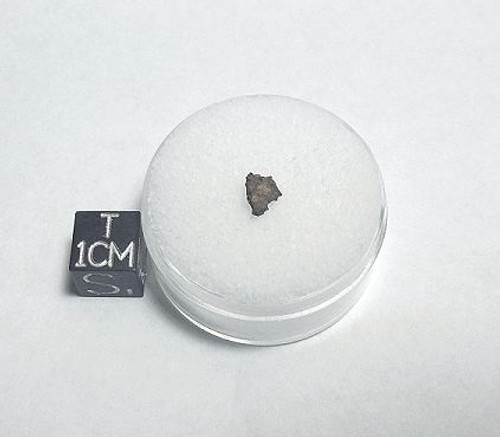On May 16th, 2019, a large and slow-moving fireball appeared in the night sky above the skies of Algeria. The meteor exploded and sent out a shockwave that was felt by observers near the Dakhla camp near the city of Tindouf. Sheperds set out to search for meteorites and the first stones were recovered the next day. Fresh samples were analyzed and classified as a shocked H5 chondrite with a shock rating of 4. This meteorite has a charactertistic battleship-grey matrix with metal flecks, sparse chondrules, and shock veins. At first glance, these stones resemble fresh examples of the Chelyabinsk fall in Russia, but the similarity stops there because these two falls are two different petrologic types. I acquired a small amount of fresh fragments and I am offering them here as low-cost micromounts.
Refer to the photo. The black centimeter cube is shown for scale and is not included. You are purchasing a small fragment like the one shown. Your purchase will include a gemjar and ID label.
From the Meteoritical Bulletin entry on Oued Sfayat :
Oued Sfayat 26°42.433’N, 6°9.766’W
Tindouf, Algeria
Confirmed fall: 16 May 2019
Classification: Ordinary chondrite (H5)
History: On May 16, 2019, a meteor was seen by a group of shepherds at 9:00 pm (local time) at the Dakhla camp in Tindouf, Algeria. The meteor came in at a low angle (about 30 °) from the west and was moving east at a relatively low velocity. A shockwave was felt as the meteor exploded, and a booming sound was heard near the camp. Hibballah, one of the shepherds present at the camp, went in search alone the following morning (May 17, 2019) for pieces of potential meteorites that may have fallen, by following the direction of the observed meteor trail and booming sound. That same day, Hibbballah recovered the first fragment, an 80 g freshly crusted individual in the area of Oued Sfayat, a river valley about 70 km to the east of the Dakhla camp. After finding this piece, Hibballah returned to the camp to tell his father Oueld Ennajm the location where he had found the first piece. Several days later, Oueld Ennajm and a some shepherds traveled to Oued Sfayat and over the next few of months went searching for more fragments. After searching between the end of May through the middle July in a 1-2 km area at Oued Sfayat, about 8 kg of freshly crusted individual fragments (mostly small stones of varying sizes between 10-60 g, with the exception of a few larger-sized individuals ~600 g) were recovered by Oueld Ennajm and the shepherds. Some of these recovered fragments were then later sold to Ahmed Chacha and Otman Sidi Ahmed. Later on, some of the purchased fragments (2.6 kg) were subsequently purchased by Youssef Bennani, who later sent some small stones in for analysis.
Physical characteristics: Stones are covered by a black, fresh fusion crust. A cut of the interior reveals a light-gray surface.
Petrography: (Daniel Sheikh, FSU) Chondrules nearly absent(400 μm, N=1). Recrystallized matrix with plagioclase (10 µm). FeNi metal and troilite present.
Classification: Ordinary Chondrite (H5)
Specimens: 23.4 grams at UCLA; main mass with Youssef Bennani.





